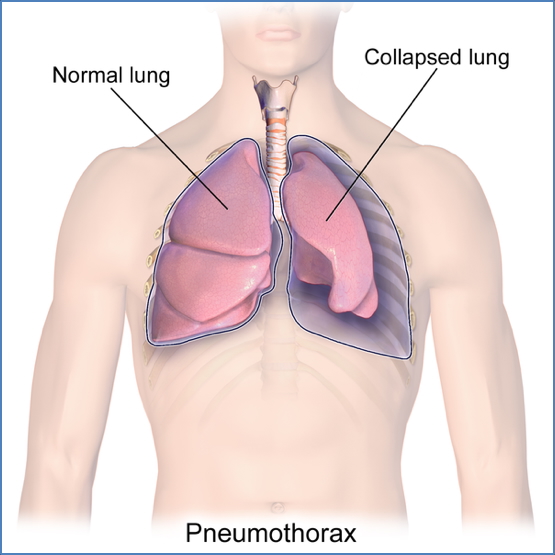Table of Contents
Overview – Pneumothorax
A pneumothorax is the presence of air in the pleural space, leading to partial or complete collapse of the affected lung. It can occur spontaneously or due to trauma, and in its most severe form—tension pneumothorax—it can cause life-threatening cardiovascular compromise. Prompt recognition and management are critical to prevent respiratory failure and death.
Aetiology
- Spontaneous:
- Rupture of subpleural blebs (e.g. in bullous emphysema)
- Traumatic:
- Penetrating chest trauma (e.g. stab wounds, rib fractures)
- Iatrogenic:
- Secondary to procedures (e.g. central line placement, mechanical ventilation)
- Associated Conditions:
- Lung cancer
- Chronic obstructive pulmonary disease (COPD)
Pathogenesis
Normal Physiology
- The pleural space maintains negative pressure that keeps the lungs expanded.
Pneumothorax
- Entry of air into the pleural space disrupts this negative pressure → lung collapse
Spontaneous
- Often due to rupture of small blebs near the lung surface
- Common in tall, thin young men or patients with underlying lung disease (e.g. emphysema)
Tension (Medical Emergency)
- One-way valve mechanism: air enters pleural space but cannot exit
- Compression of major vessels, ↓ venous return, and mediastinal shift
- Can lead to:
- Severe respiratory distress
- Tracheal deviation
- Cardiovascular collapse

Clinical Features
General Symptoms
- Pleuritic chest pain (sharp, localized)
- Dyspnoea (shortness of breath)
Signs (Tension Pneumothorax)
- Tracheal deviation (away from affected side)
- Hyperresonance on percussion
- Reduced breath sounds on affected side
- Tachycardia, hypotension
- Distended neck veins
- Respiratory distress
Investigations
- Chest X-ray:
- Absent peripheral lung markings
- Visible pleural line
- Collapsed lung margin
- Mediastinal shift (in tension pneumothorax)
- CT Chest:
- Better sensitivity for small pneumothoraces or when looking for cause (e.g. tumour, rib fracture)

Management
Emergency (Tension Pneumothorax)
- Immediate needle decompression:
- Large-bore cannula in 2nd intercostal space, midclavicular line
- Chest drain insertion:
- Tube thoracostomy with underwater seal or one-way valve
Other
- Oxygen therapy
- Treat underlying cause
- Chest physiotherapy (post-stabilisation, to improve re-expansion and prevent pneumonia)
Summary – Pneumothorax
Pneumothorax refers to the presence of air in the pleural cavity, which can cause partial or complete lung collapse. It may occur spontaneously or due to trauma, and can escalate to a life-threatening tension pneumothorax. Rapid identification and intervention are critical. For broader context, visit our Respiratory Overview page.